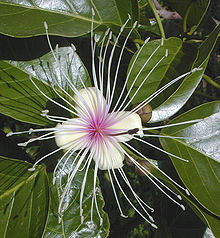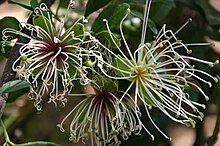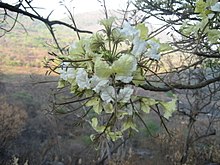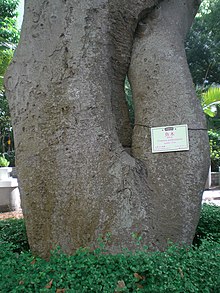Capers
| Capers | ||||||||||||
|---|---|---|---|---|---|---|---|---|---|---|---|---|

Real caper bush ( Capparis spinosa ) |
||||||||||||
| Systematics | ||||||||||||
|
||||||||||||
| Scientific name | ||||||||||||
| Capparaceae | ||||||||||||
| Yuss. |
Capers (Capparaceae) are a family of plants in the order of the cruciferous (Brassicales).
description



Vegetative characteristics
They are mostly woody plants: trees , bushes or lianas , rarely herbaceous plants ; some species are climbing plants, many species are xerophytic . Most of the species are evergreen; Some Crateva species are deciduous . Plant parts often have branched or simple hairs ( trichomes ).
The leaves are usually arranged alternately or rarely opposite. The leaf blades are simple or composed with three to rarely nine leaflets. If stipules are present, then they are prickly or small.
Generative characteristics
The flowers are arranged individually or in groups of two to ten in racemose , umbrella-racemic panicle or almost dold-like inflorescences over bracts.
The mostly hermaphrodite, sometimes unisexual flowers are almost radially symmetrical to zygomorphic and often fourfold. There are one or two circles with four sepals each, which can be the same or different. Petals are usually four, rarely many or eight are present or they are missing, they can be keeled. Often there are many (rarely four, often six to 20 or up to 100) stamens present, the stamens are often long. Often gynophores or rarely androgynophores are formed. There are two to twelve carpels each. The ovary is on top. There is a discus.
Often berries or capsule fruits , rarely stone fruits or nuts with one to many seeds are formed. The kidney-shaped to polygonal seeds are smooth or sculpted differently and contain a straight embryo; there may be some endosperm .



Systematics and distribution
They occur mainly in tropical and subtropical climates, only a few species reach into the temperate areas.
The family of the Capparaceae were set up in 1789 by Antoine Laurent de Jussieu under the name "Capparides" in Genera Plantarum , pp. 242–243. The type genus is Capparis L. A synonym of Capparaceae Juss. is subfam. Capparoideae.
The family Capparaceae contains about 16 to 29 genera with about 480 to 650 species :
-
Anisocapparis Cornejo & HHIltis : It was only set up in 2008 and includes only one species:
- Anisocapparis speciosa (Griseb.) Cornejo & HHIltis : It occurs in Bolivia, Argentina and Paraguay.
-
Apophyllum F. Muell. : It contains only one type:
- Apophyllum anomalum F. Muell. : It occurs in northeast Australia.
-
Bachmannia Pax : it contains only one species:
- Bachmannia woodii (olive) Gilg : It occurs in southern Africa.
-
Belencita H. Karst. : It contains only one type:
- Belencita nemorosa (Jacq.) Dugand ; it occurs in Colombia and Venezuela.
-
Borthwickia WWSm. : It contains only one type:
- Borthwickia trifoliata W.W.Sm. : It occurs in southern Yunnan and eastern and northern Myanmar .
- Boscia Lam. ex J. St.-Hil. : The approximately 37 species occur in Africa, Arabia and Madagascar.
- Buchholzia Engl .: The only two species occur in West Africa.
- Cadaba Forssk. : The 30 or so species thrive in the tropics and are particularly common in Africa.
- Capparicordis H.H.Iltis & Cornejo : With only three species; they occur in the Neotropic.
-
Capers ( Capparis L. of about 270 types, or including Calanthea . (DC) Miers , Capparidastrum Hutch. , Colicodendron Mart. , Hispaniolanthus Cornejo & ferret , Neocalyptrocalyx Hutch. , Quadrella J. Presl then with about 400 species), including, for example:
- Cape caper ( Capparis spinosa L. )
-
Cladostemon A. Braun & Vatke : It contains only one species:
- Cladostemon kirkii (Oliv.) Pax & Gilg ; it occurs in southern and southeastern Africa.
- Crateva L. (Syn .: Belou Adans. , Crataeva L. , Nevosmila Raf. , Othrys Noronha ex Du Petit-Thouars , Tapia Mill. , Triclanthera Raf. ): With about 10-14 species, with worldwide occurrences in the tropics and Subtropical and extending north to southern Japan in Asia, south to northern Argentina in America. There are five types in China.
- Cynophalla J. Presl (the species are alsoplaced under Capparis ): There are about 20 species that occur in the Neotropic.
-
Dhofaria A.G. Mill. : It contains only one type:
- Dhofaria macleishii A.G. Mill. : This endemic occurs only in Oman .
-
Dipterygium Decne. : It contains only one type:
- Dipterygium glaucum Decne. : It occurs from Egypt to Pakistan.
- Euadenia Oliv. ; with three species that occur in tropical Africa.
- Forchhammeria Liebm. : The approximately ten species occur from California to Central America and the islands of the Caribbean.
- Maerua Forssk. (Syn .: Courbonia Brongn. ): With around 100 species in the tropics, especially in Africa.
-
Mesocapparis (Eichler) Cornejo & HH Iltis : It contains only one species:
- Mesocapparis lineata (Pers.) Cornejo & HHIltis : It occurs in Brazil.
- Monilicarpa Cornejo & HHIltis : With only two species; they occur in South America.
- Morisonia L .: With about five species in the Caribbean and in tropical South America.
-
Neothorelia Gagnep. : It contains only one type:
- Neothorelia laotica Gagnep. : It occurs in Southeast Asia.
-
Poilanedora Gagnep. : It contains only one type:
- Poilanedora unijuga Gagnep. : It occurs in Southeast Asia.
-
Puccionia Chiov. : It contains only one type:
- Puccionia macradenia Chiov. : This endemic occurs only in northern Somalia .
- Ritchiea R.Br. ex G.Don : The 30 or so species occur in tropical Africa.
-
Sarcotoxicum Cornejo & Iltis : It contains only one species:
- Sarcotoxicum salicifolium (Griseb.) Cornejo & HHIltis : It occurs in Argentina.
- Steriphoma Spreng. : The eight or so species occur from Guatemala via Trinidad to Venezuela and Peru.
- Stixis Lour. (Syn .: Roydsia Roxb. ): The seven or so species are distributed from the eastern Himalayas to Hainan and the Lesser Sunda Islands .
- Thilachium Lour. : The approximately 13 species are distributed from Somalia to southeast Africa and Madagascar as well as on the Mascarene Islands .
-
Tirania Pierre : It contains only one species:
- Tirania purpurea Pierre : It occurs in southern Vietnam.
Depending on the author, genres are classified here or in other families of the Brassicales ; the system is currently still under discussion here. So z. For example, the four genera Forchhammeria , Neothorelia , Stixis and Tirania may be classified in a separate new family of the Stixaceae and the genus Borthwickia may also come into its own family Borthwickiaceae.
ingredients
Mustard oil glycosides are always present (close relationship with the cruciferous family (Brassicaceae)).
use
With the capers , the flower buds are eaten. Capparis spinosa and Capparis ovata are mainly found in the Mediterranean area; the annual caper production (as a spice) is 10,000 tons.
swell
- The family of Capparaceae in APWebsite . (Section description and systematics)
- The Capparaceae family at DELTA . (Section description)
- Mingli Zhang, Gordon C. Tucker: Capparaceae. , P. 433 - same text online , In: Wu Zheng-yi, Peter H. Raven, Deyuan Hong (Eds.): Flora of China. Volume 7: Menispermaceae through Capparaceae. Science Press / Missouri Botanical Garden Press, Beijing / St. Louis 2008, ISBN 978-1-930723-81-8 (Sections Description and Systematics)
Individual evidence
- ^ Antonii Laurentii de Jussieu: Genera plantarum , pp. 242–243 scanned in at biodiversitylibrary.org.
- ↑ a b Capparaceae in the Germplasm Resources Information Network (GRIN), USDA , ARS , National Genetic Resources Program. National Germplasm Resources Laboratory, Beltsville, Maryland.
- ↑ a b c d e f g h i j k l m n o p q r s t u v w x David John Mabberley: Mabberley's Plant-Book. A portable dictionary of plants, their classification and uses. 3rd edition Cambridge University Press 2008, ISBN 978-0-521-82071-4 .
- ^ Gordon C. Tucker: Capparaceae Jussieu. In: Flora of North America, vol. 7. [1] .



